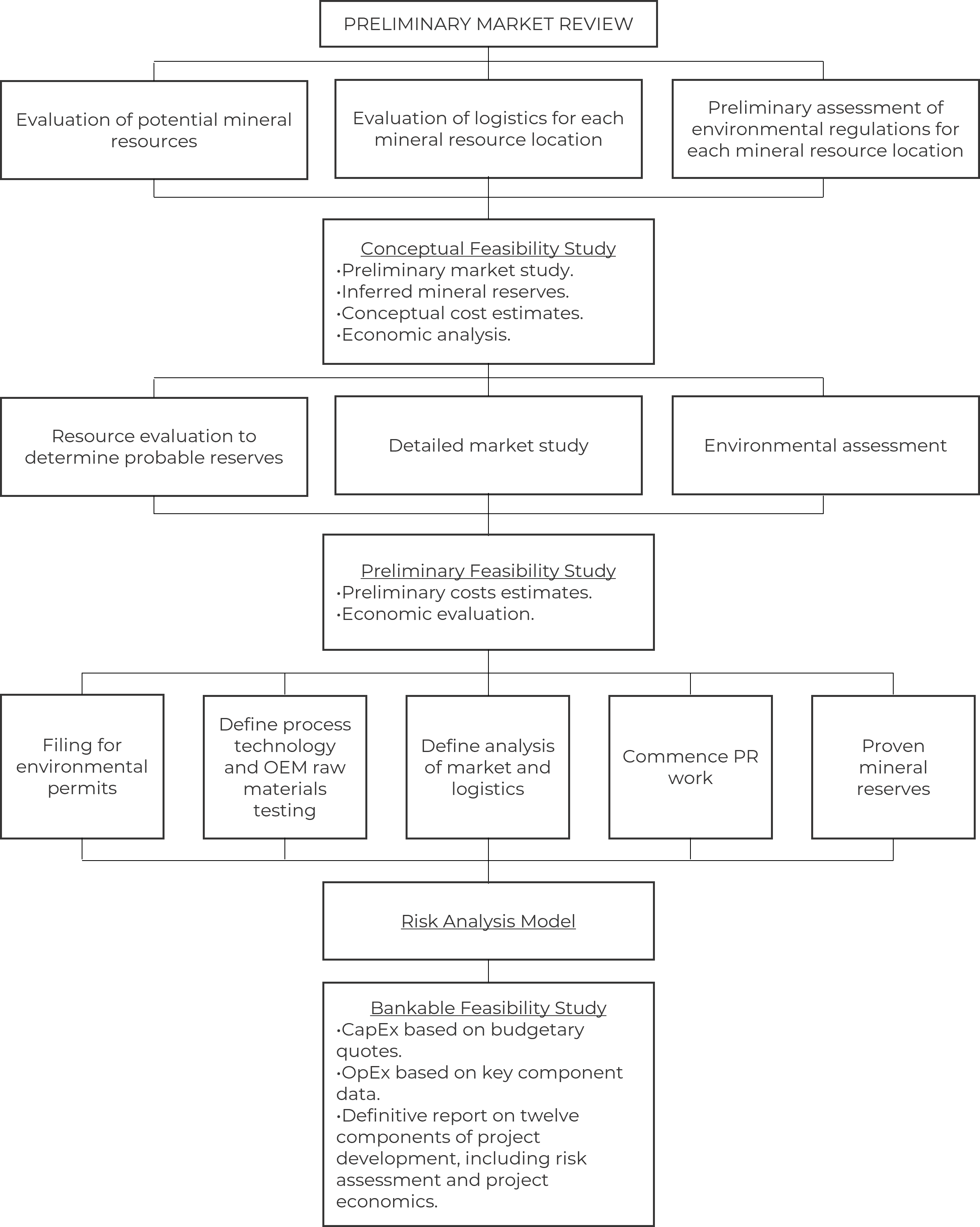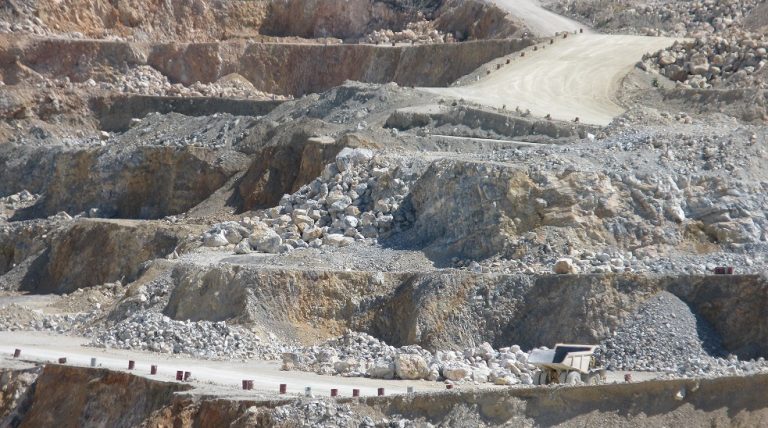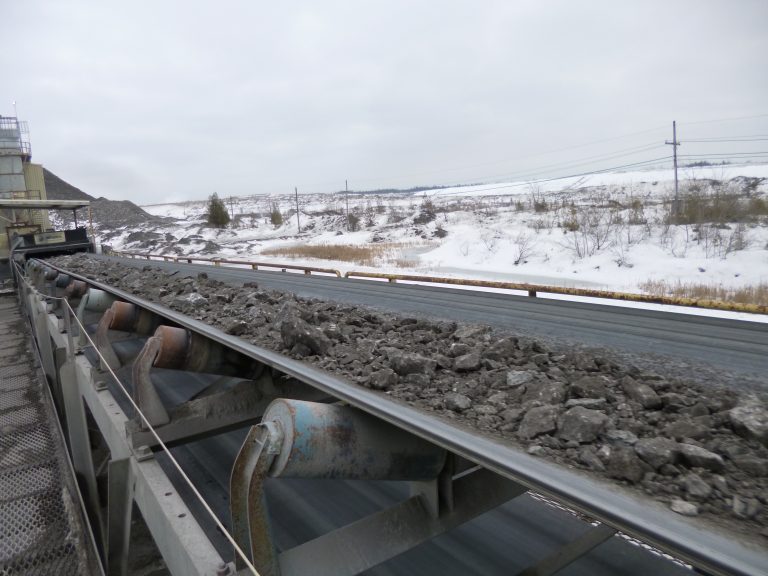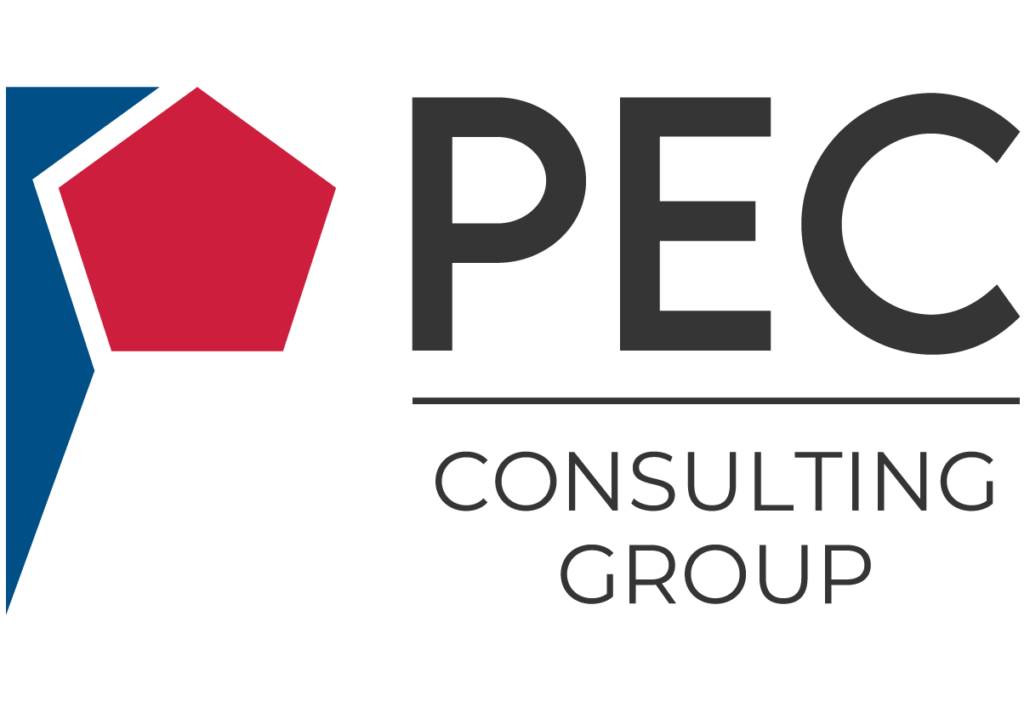Pitfalls in Project Development for an Industrial Minerals Processing Plant
By Francisco M. Benavides
Development of a minerals processing facility is complex and requires extensive planning and due diligence. The focus generally goes into the technology to be utilized and the engineering for the project. However, it is important to fully understand the physical and chemical properties of the mineral resource to be utilized and how it relates to the target market. Raw materials can be mined minerals or byproducts from other industries.
The aspects to be considered in project development are as follows:
-
- Geology
- Market
- Logistics
- Competition
- Environmental
- Public Relations
- Technology
- Human Resources
- Capital Investment
- Working Capital
- Operating Costs
- Economic Analysis
All the above have innate levels of risk which could potentially affect the success of the project. Based on experience and intuition, the project team may gravitate to placing more emphasis on some of the aspects, but all project parameters need to be analyzed in great detail for potential risk.
Figure 1. Project Development Phases

1. Evaluation of Mineral Deposits
The minerals to be processed must be properly qualified and quantified. Failing to do so results in an inadequate process which causes operational problems and costly plant modifications. If the operation is based on a single raw material, as in lime or diatomaceous earth, fully understanding the physical and chemical properties of the deposit is an absolute requirement. In the case of cement, where several raw materials make up the raw mix, there may be some forgiveness in the resource analysis if the corrective minerals are available to adjust the chemistry of the raw feed. In any case, there is no excuse if a major investment takes place without properly understanding the mineral resources to be utilized.
Geological exploration, sampling and material testing must be done by qualified professionals and reviewed by independent consultants. This work can be done in phases so as not to waste money on mineral deposits which do not prove out during initial exploration. This is not a project development aspect where to skimp on budget. There are too many horror stories where the lack of thorough geological exploration, sampling and testing resulted in the wrong process design and selection of equipment.
Standards for geological exploration such as Canadian Standard NI 43-101 or the US SK-1300 should be followed to properly determine the mineral reserves.

2. Market Analysis
It is critical that the market be analyzed in detail; that is, it should comprehend both a macro analysis as well as direct communications with potential customers. Knowing the product quality and specifications that can be generated from the raw materials is the first step in identifying the potential market. Pairing the product with the market can be done by an experienced consultant. The macro market data can be obtained by a specialized market research firm based on specifications from the lead project consultant. The market consultant analyzes the data and develops conclusions as to the market potential for the project. Information on the overall market potential will serve for the first stages of the feasibility study.
Once a general understanding of the market is reached, a more detailed market research is required. This detailed market analysis requires more time and effort including amount of field work, visiting with potential customers and networking within the industry for identification of additional potential customers. This research includes obtaining real pricing being paid for the competitors’ products, including issues with quality and service.
There are many ways to carry out a market study and many possible resources. What matters is that the resulting information is sufficiently reliable to develop the project further. The market study will provide critical data to be used in developing the project economic analysis and will be a key aspect in the evaluation by any entity providing financing for the project.
3. Logistics
Most industrial minerals are low-cost commodities in the sense that the cost of the mineral to the end user will be significantly impacted by freight, warehousing, and other distribution costs. This applies to any transportation cost from mine to processing plant and from the plant to the consumer. In general terms, an industrial mineral only has value where the deposit is close to infrastructure; that is, road, rail, water, power transmission lines, fuel supply and other services.
The most economical transport is by water in ships or barges, followed by rail and truck. In the project analysis, it is therefore important to consider the cost of logistics as in many cases it may render the project uneconomical. The focus needs to be the all-encompassing delivered cost to the customer and how this compares with the competition, assuming comparable quality and service.
4. Competition
Analyzing the competition is a critical aspect of the feasibility of the project in which both existing and potential competitors are analyzed. Questions to be considered are:
-
- Who is the competition for the product we are proposing to place in the market?
- What quality are they delivering?
- What are their operating costs?
- What strengths and weaknesses do they have in relation to our proposed project?
Much of this information could be gathered during the market study. There are many ways to gather information on the competition. This can be done by talking to potential customers, researching posted product specifications and permit filings. This last item can be of significance if a competitor has filed for permits to increase capacity or modify existing production.
A SWOT analysis of the project’s potentials versus those of the competitors will help understand the opportunities for the project.
5. Environmental
Permits may have more of an impact on the project schedule than any other factor. In most cases, there is a significant amount of work that needs to be done in preparation for the filing of the permits. An environmental consultant with experience in the industry and the project general location should be retained as part of the project team to determine the requirements of the responsible governmental agencies. If environmental data is not available for the general area of the project, data will need to be gathered as a reference base for the permit applications.
Basic engineering needs to be developed by the project consultant to provide the estimated emissions which will be generated by the mining and processing plant operations. The time necessary to prepare for filing permits, the filing itself, and follow up work leading to the eventual issuance of the draft permit, public reviews, to eventually obtain the final construction and operation permits is significant, and often underestimated by project developers.
6. Public Relations
The lack of consideration of this subject is one of the major causes for stopping or delaying the development of a project. Financial wherewithal and political connections may not help because an unhappy neighbor can cause project delays due to a sense of lack of consideration and respect. The project developer must consider all stakeholders as important and give all potential entities impacted by the project the time to ask questions and voice opinions. Many times, educating people on the project details may prevent problems in the permitting process. One customer leased a shop in a nearby town and laid out displays explaining in great detail information on the project. Lack of information causes suspicion and the creation of negative rumors. It is recommended that a public relations specialist be retained to assist in the process of creating a positive attitude by the neighbors for the project.

7. Technology
Determining the technology to be utilized for the project will help the development of all other aspects of the feasibility study. The technology firms or original equipment manufacturers (OEMs) will help with testing of raw materials and fuels, provide equipment sizing and verifying the projected emissions from the process originally calculated by the consultant. The OEMs will also provide budgets which will be used for capital and operating cost estimates.
During the feasibility study, the process specifications should be developed by the consultant, a bid package developed and invitations to bid issued. By the time the feasibility study is completed, the OEMs have been selected for the main process equipment.
8. Human Resources
People make all the difference. In evaluating projects, it is essential to consider the human resources that will be required to execute the project and operate the facility, taking into account all aspects of project development and execution, and operating staff. Mineral processing plants are located usually close to the raw materials to be processed in remote locations where staffing may be a problem. For construction, a remote location will signify a higher capital investment.
For operations, finding talent willing to relocate to locations where quality housing and services are not readily available is a challenge and may need to be counteracted by higher salaries and possibly investing in the local community to upgrade services. The feasibility study for a project needs to take these issues into consideration in estimating the economics of the project.
9. Capital investments
Mining and mineral processing projects require significant capital outlays. The equipment is expensive and requires heavy industrial construction to withstand the vagaries of the heavy-duty round-the-clock operations. The design criteria must be set and sufficient engineering done to allow an experienced estimator to prepare a reliable capital cost estimate. Materials to be processed need to be tested both by independent laboratories and selected OEMs’ laboratories and pricing obtained from major equipment suppliers. Depending on the level of engineering and procurement activities, contingencies need to be applied to portions of the project according to team based risk analysis. Most times, errors in CapEx work occur not only by miscalculating costs of listed components, but also from missing key components of the project. Why do so many projects go over budget? There are many reasons, but a few potential ones:
-
- Project schedule. Time costs money, any delay to the project will add significant costs. Delays can be caused by acts-of-god which cannot be avoided. However, most delays occur due to logistics. Late deliveries to site of key materials and equipment, design errors, lack of expediency in the procurement effort, contractual issues and in general poor planning are major reasons.
- Incomplete engineering, that is, starting the project before proper engineering has been done to ensure timely deliveries and construction execution. If the project needs to be fast-tracked, engineering is not the place to pinch on budget. Investing in engineering is the only way to have a successful fast-tracked project because engineering will need to be developed as the project moves along and more hours will be required than in a phased project development mode.
- Unrealistic budget. In order to have a project approved, the CapEx of the project is lowballed when presented to management to receive approval. This is quite common, and it is based on wishful thinking by lowering contingencies and developing an unrealistic schedule.
10. Working Capital
This is part of project development costs that are usually underestimated. Before a facility achieves steady operation in manufacture and sales, sufficient cash to cover operating costs will be required. Working capital must be accounted to cover start up and operational costs encompassing supplies, labor, fuel, electrical power, maintenance, etc. The financing of the project also must be taken into account. The working capital must be such that in the economic analysis it balances negative cash flow for the duration anticipated until sales balances against expenses.
11. Operating Costs
A detailed list of all operating costs is required to ensure all costs are accounted. For this purpose, a consultant with operating experience in the industry is of high value. Alternatively, the owner of the facility may have similar operations which could be audited to account for all operating costs. It is important that both direct and indirect costs be considered. A significant cost, often not taken into account, despite its significance relates to logistics, incoming and outgoing. On a per ton basis, logistics can have a significant impact on the project economics.
12. Economic Analysis
Analyzing the economic viability of a project requires many inputs other that the capital investment and operating costs. Unlike metals, industrial minerals may require a ramp up in sales over a period. Fixed costs are not affected by sales volumes and cash flow depends heavily on sales. It is important that the consultant deduce from the market study the period to ramp up to full production. Other important factors affecting the present value of the project are the cost of capital, taxes, allowed depreciations, depletion when allowed, and other costs which may be charged against the project such as royalties, corporate charges, etc.
Conclusions
There are of course many unknowns in the analysis of a project, some which may be outside the control of the project developer but making sure that the twelve aspects described above are considered carefully will provide the developer and the financing organizations investing on the project a sense of confidence in undertaking the project. As the project develops through the various levels of feasibility analysis, a risk assessment of each of the twelve project aspects should be carried out by the project team and appropriate external consultants. Several methods are available to define the probability of risk on every project aspect and the overall effect on the project from an occurrence. Nothing guarantees total project success; however, not following a process increases the probability of unsatisfactory results.
About the Author(s)
Francisco M. Benavides, P.E.
Mr. Benavides, Principal Consultant at PEC Consulting Group LLC, has many years of experience in project management, design and construction. He has conducted bankable feasibility studies, economic analysis of mineral transport alternatives, plant valuations for acquisitions and for financing purposes, and due diligence studies. He holds an MBA from Kellogg School of Management, Northwestern University, Evanston, Illinois; a Bachelor of Science and Professional Degree in Civil Engineering from the Missouri University of Science & Technology, Rolla, Missouri; and has completed Graduate Studies in Engineering Management and Environmental Engineering at Missouri University of Science & Technology.
PEC Consulting Group LLC | PENTA Engineering Corporation | St. Louis, Missouri, USA
How can we help you? Get in touch with our team of experts.
